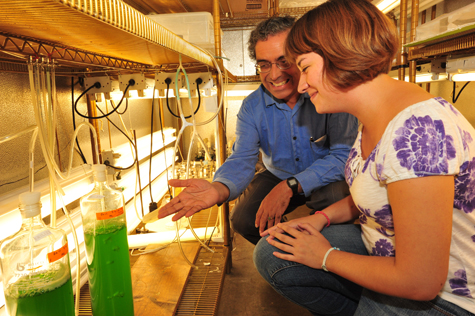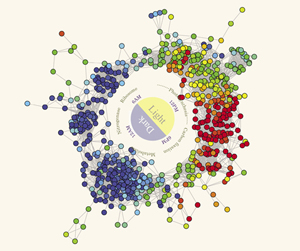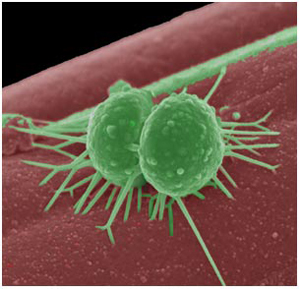
During World War II, German scientists discovered that some strains of algae, when starved of nutrients, quickly build up oil in their cells. The war ended, and the discovery lay dormant until people began to search in earnest for greener alternatives to fossil fuels.
In the early 2000s, algal fuel production enjoyed a tremendous vogue, as scientists and venture capitalists were seduced by the notion of converting “pond scum” to oil. But a recent wave of bankruptcies has made it clear that algae biofuel companies got ahead of the science.
To address this shortfall, the Department of Energy has funded a three-university collaboration led by Washington University in St. Louis to approach the problem of algal fuels systematically.
The principal investigator on the grant is Himadri Pakrasi, PhD, the George William and Irene Koechig Freiberg Professor of Biology in Arts & Sciences, professor of energy in the School of Engineering & Applied Science, and director of the International Center for Advanced Renewable Energy and Sustainability (I-CARES).
In a two-step project, groups at Washington University, Purdue University and Pennsylvania State University will first attempt a comprehensive understanding of the metabolic machinery of selected cyanobacterial strains and then implement that understanding by assembling a novel bacterium with the metabolic machinery needed to produce fuel molecules.
Far from outrunning the science, the team will be bringing to bear the most sophisticated approaches contemporary biology now has to offer: systems biology and synthetic biology.
Systems biology is the discipline that takes into account the full complexity of a cell’s metabolic machinery before abstracting a simpler model consisting of the essential metabolic pathways. This route to simplicity through complexity — made possible by automated high-throughput lab equipment and powerful computers — stands to some extent in opposition to the reductionism that has long characterized biology but is increasingly unable to deal effectively with the outpouring of new data.
A systems biology approach integrates layers of information contained in large data sets that identify the molecules important to a cell’s metabolism and their interactions. The study of each layer of information is a discipline in itself; together they are informally called the “omics.” Pakrasi’s team, for example, plans to include cyanobacterial phenomics, genomics, transcriptomics and metabolomics within the sweep of its study.

“Although it might seem that systems biology would lead to information overload,” says Pakrasi, “the goal is to locate the control points, or the hubs in the network where many pathways intersect. This actually gives scientists much finer control over the organism than if they were to reach in blindly and replace one node without understanding what role that node plays in the complex network that gives the organism its robustness and resilience.
“It all depends on the questions you ask of the data,” Pakrasi says. “You want to know the important things, just as, when you look at a car, you want to know first how many cylinders it has, not how many nuts and bolts.”
The second step in the process, synthetic biology, gained notoriety when Craig Venter of human genome fame announced in May 2010 that his team had created the first synthetic bacterium. Since Venter’s team put newly constructed parts into existing but empty cells of brewer’s yeast (Saccharomyces cerevisiae), some said the organism was not entirely new and so couldn’t claim the title of the first entirely synthetic organism.
In fact, however, synthetic biology is an elastic discipline that includes any attempt to design and construct biological functions or systems not found in nature.

Yuri Gorby, Pacific Northwest National Laboratory
An electron micrograph of Synechocystis, the cyanobacterium that will be used as the “chassis” for the assembly of a synthetic fuel-producing bacterium.
Pakrasi’s team plans to take a similar approach. In their case the “chassis,” as Pakrasi calls it, will be the cyanobacterium Synechocystis 6803 rather than brewer’s yeast. Synechocystis 6803 has been studied for more than 25 years and has the distinction of being the first photosynthetic organism to have its genome sequenced.
“The knowledge base for this organism is huge,” Pakrasi says. “For example, three years ago, we published a paper that included information not just from our lab but also from 17 other labs that collectively describes the behavior of Synechocystis at the level of gene expression under 151 environmental conditions.
“In many ways Synechocystis is a run-of-the-mill cyanobacterial strain,” Pakrasi says, “just one we know a lot about. The systems biology work we are doing with other strains will allow us to identify useful metabolic modules that Synechocystis does not have, and add them to Synechocystis as needed to create a family of bugs tailored to produce a range of fuels or fuel precursors.”
One of the reasons Synechocystis is such a good lab rat is that, even though it is called a blue-green alga, it is really a bacterium. As is true of many other bacteria, its DNA can easily integrate foreign DNA. The initial wave of enthusiasm for algal fuels, on the other hand, was based on micro-algae, which are essentially single-celled plants. The genomes of most of them are not as easy to manipulate. They’re also much bigger, more elaborate and less understood.
“People all started with micro-algae because they were already making a ton of oil,” Pakrasi says. “But guess what? So little is known about their biology that you cannot do anything with them beyond what they’re already doing by themselves. You don’t have the option to go in there and modify the genome or make changes in the cellular composition that will allow you to achieve your goal in a more facile way.
“People used to say, ‘Well, cyanos don’t make oil.’ That may be true, but we can engineer them so that they make oil, and that is what is happening now.”
The algal fuel industry is coming back to take a second look at cyanobacteria. “But,” says Pakrasi, “compared to us they are newcomers to this field; we’ve got a 25-year head start.”